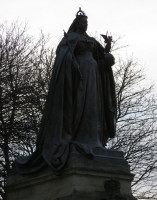
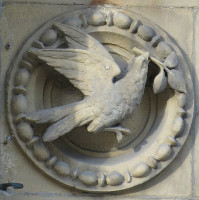
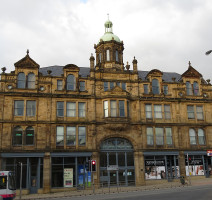
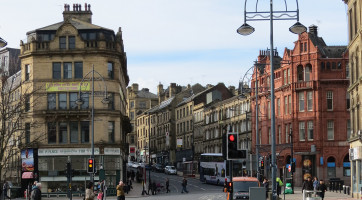
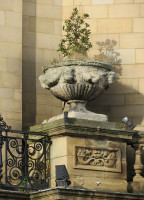
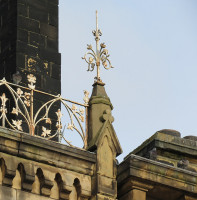
Bradford, of some antiquity in its origin, did not really develop until the late 18th century, and really took off as a major conurbation only in the 19th Century, becoming the centre of the Worsted woollen industry, and having some considerable number of coal, and of more interest to these pages, was (and is) important for the Bradford Stone quarries, where a beautiful tan-coloured stone was quarried in such large quantities that almost all the buildings in the town were built of it. While modern town planners have done various brutal things to whole swathes of the city – for Bradford was elevated to city status at the end of the 19th Century – it remains essentially a Victorian conurbation, with many splendid streets of tall, tan and dun-coloured buildings, in narrow streets romantically winding up and down the undulating landscape.
Bradford Cathedral tower, late 16th Century, behind Victorian buildings.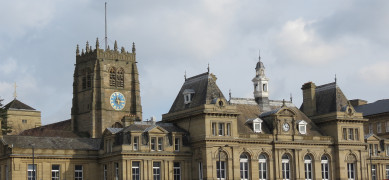
The oldest building is the former Parish Church, converted to become Bradford Cathedral and added to as late as the 1950s and 60s to bulk it up with an extended East end and side wings, but with a tower commenced in the late 15th Century, and interior of the nave dating from as early as the 14th Century. The monumental sculpture in Bradford Cathedral is described on this page.
There are a few buildings from the late 18th Century through to the 1820s, when Bradford’s population began to mushroom, but the most important buildings are from mid-Victorian times and later. Three great buildings of these times are St George’s Hall (1851-1853), the Wool Exchange from a decade later, and the Town Hall from the 1870s (with later additions). All three were by a local architectural firm, Lockwood and Mawson, who were favoured by the civic authorities over imported architecture from further afield.
Bradford's St George's Hall, 1853, and sculptural details.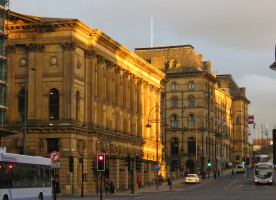
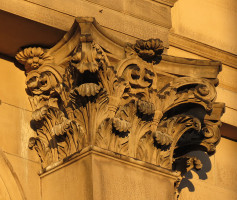
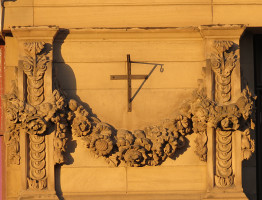
St George’s Hall is a Classical pile with Corinthian pillars and pediment near to the station. It is suitably grand, but the sculptural adornment is largely confined to the capitals of the attached pillars and pilasters, and various floral festoons at first floor level. These are well made, but an opportunity was missed to fill the pediment with Victorian sculpture.
Bradford Wool Exchange, and statues by James Tolmie, 1860s.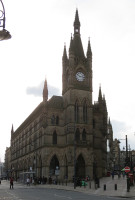
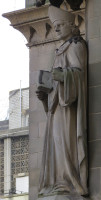
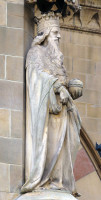
By contrast, the Wool Exchange is a fantastical Gothic building of 1864-67, with spiky clock tower and smaller spires. And close to the heart of these pages, it has sculpture too – a series of roundels with portraits of various great men associated with Bradford, and by the main corner entrance, two full statues in stone. These two at least are by the sculptor James Tolmie; the roundels would seem to be by some lesser figure. Tolmie himself is very obscure, and I had not come across him before seeing the Bradford statues. He was based in London, and apart from these Bradford statues, his recorded work is that of a carver and assistant to others rather than in his own right, including carvings for the Whitehall Club, Inns of Court Hotel, and a hotel at Buxton. He died in 1866, and the Bradford statues were completed posthumously by another sculptor, presumably being installed at the opening of the building in the following year. One of them is of Saint Blaise, an Armenian Bishop whose martyrdom involved being scratched with wool combs, thus leading to him becoming the patron saint of the wool trade. He is shown as a young man, in vigorous health, holding a large wool comb and some smaller instrument. He is dressed in long robes down to his feet, carved simply but well, and the hands at least show evidence of fine carving, though restoration, presumably with necessary removal of decayed stone, has left the statue looking somewhat bereft of fine detail. The other statue, of a medieval king, ascribed by Pevsner as likely to be Edward III, who supported the wool trade, is depicted as an older man, with flowing hair and beard, a mantel, and holding orb and sceptre. This statue, in better repair than the Bishop, shows some careful carving of fabric, hands and face.
The third great building by Lockwood and Mawson is Bradford City Hall, subject of a separate page. Suffice to say here that the extensive scheme of statues adorning the building, by the sculptural firm of Farmer and Brindley, make this the pre-eminent sculptural work in Bradford, and one of the most significant works of architectural sculpture of Victorian times.
Bradford Technical College, 1882, and Grove Library, Great Horton Road.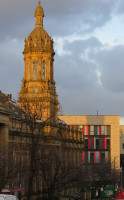
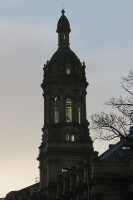
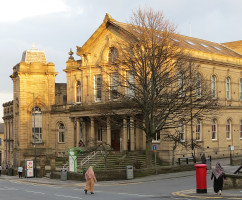
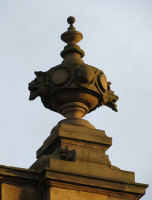
There are of course other significant Victorian buildings in Bradford, and we mention here just a couple of examples. On Great Horton Road, the main building of Bradford Technical College dates from 1882, established with Schools in Textiles, Engineering, Art and Design, and Chemical Dying, all to support the great woollen manufacturies of the town. The main feature is the tower, with decorated columns, free-standing pots, and other minor decorative sculptural elements, and on the façade, several bearded keystone heads (see this page for more of this ilk). Opposite is the Grove Library, with classical portico and more free standing pots as acroteria to the main frontage gable. Close by on the corner with Chester Street is the German Protestant Church, a converted 1860s building given an Alpine feel with the addition of a pointy little tower. Near the Cathedral is a whole area of the city called ‘Little Germany’, where lie some of the best free-standing warehouse buildings, with various degrees of sculptural decoration. And we must mention one building, at the beginning of Sunbridge Road facing the City Hall, in defiant red terra cotta - it is the Prudential Assurance Buildings, by Alfred Waterhouse of course. It may be seen in one of the pictures at the top of this page.
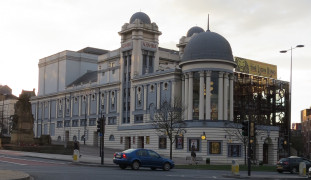
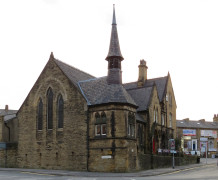 Alhambra Theatre, and German Protestant (Evangelical) Church.
Alhambra Theatre, and German Protestant (Evangelical) Church.
A bit closer to the town centre is an early 20th Century building, the Alhambra Theatre, of 1913, rather seaside style, with exotic domes, matched by the smaller, later ones on the Cinema behind (Odeon), which were built to match. And by this building is Victoria Square, forming a small sculptural enclave – see this page.
Bradford City Hall // Victoria Square, Bradford
Sculpture in England // Sculpture pages
Visits to this page from 1 April 2014: 9,739